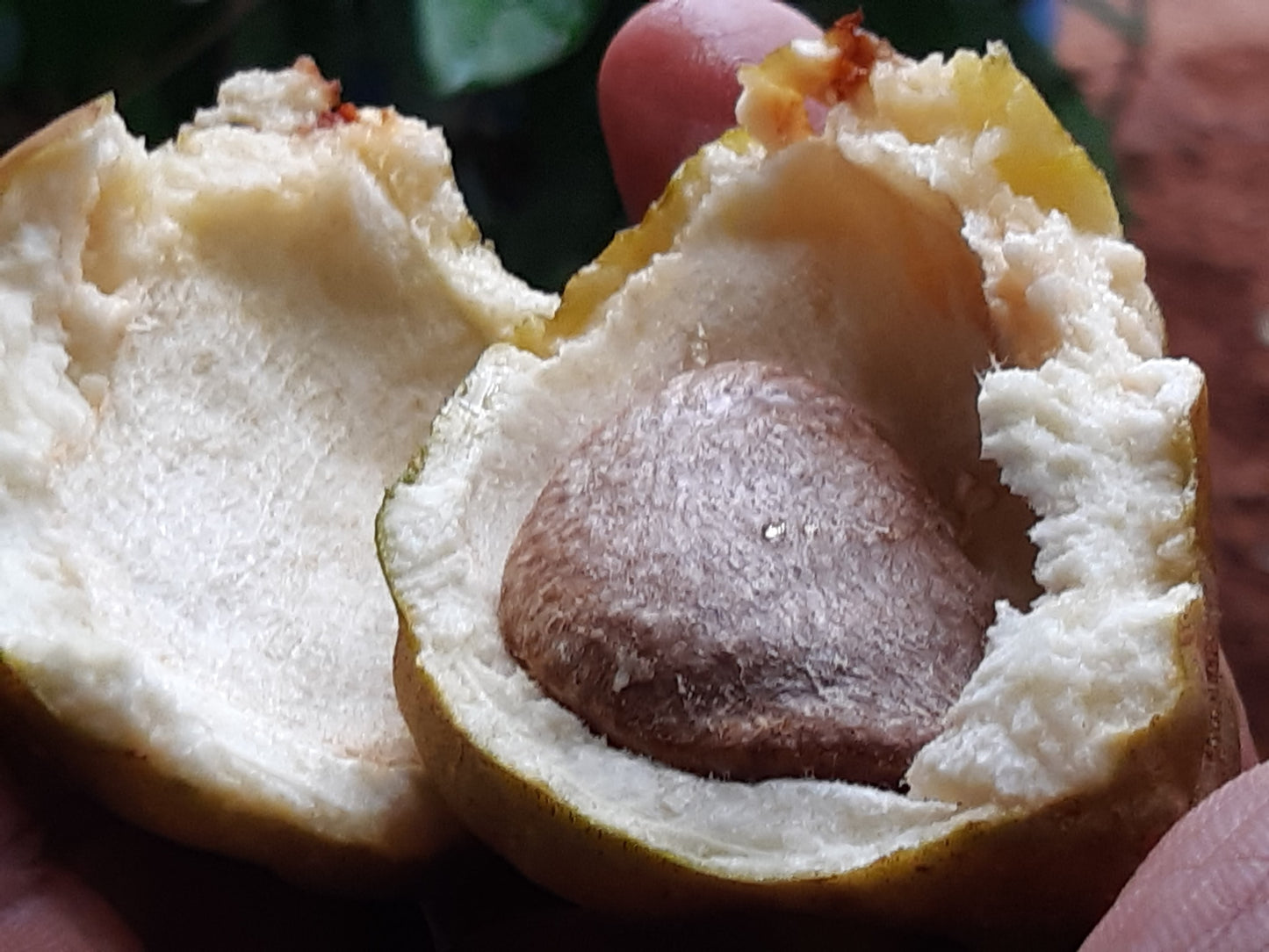Love it? Add to your wishlist
Your favorites, all in one place. Shop quickly and easily with the wishlist feature!
[message]
[title]
[message]




Veliyath Gardens
Couldn't load pickup availability
In the vibrant rainforests of Southeast Asia, a curious-looking fruit hangs low on the trunk of a modest, slow-growing tree. With a wrinkled surface and kidney-shaped body, the Nam Nam Fruit—known scientifically as Cynometra cauliflora—may not catch the eye at first glance. But for those who know it well, this rare tropical fruit is a silent treasure, revered in folk medicine and slowly making its way into select exotic gardens around the world.
Common Name: Nam Nam Fruit
Botanical Name: Cynometra cauliflora
Other Regional Names:
Malaysia: Katak Puru (meaning “Toad’s Skin”)
Indonesia: Namu Namu
India (Southern regions): Puki Anjing
Though relatively obscure in modern markets, the Nam Nam fruit has long held value in traditional cultures across Malaysia, Indonesia, India, and Sri Lanka—both for its medicinal utility and its unique taste.
Nam Nam fruit grows directly from the trunk and branches—a botanical phenomenon called cauliflory. The fruit’s skin is coarse and wrinkled, often brownish-green, resembling the texture of toad skin. Inside lies a soft, juicy, yellow pulp that is aromatic and flavorful.
Taste Profile:
Flavor: Mildly sweet with a pleasant tartness when fully ripe
Texture: Juicy with a slightly fibrous body
Aroma: Earthy and subtly floral, especially when the fruit is freshly harvested
In its unripe stage, the fruit leans more toward the sour end, and is sometimes used in pickles or chutneys. Ripe Nam Nam is suitable for fresh consumption, especially for those who appreciate tropical fruits with complex, layered taste notes.
The Nam Nam fruit is not only known for its taste but also for its medicinal applications, especially in traditional Southeast Asian healing systems.
Traditional Health Uses:
Blood Pressure Management: Both the fruit and young shoots are consumed to help regulate hypertension.
Diabetes Control: Its glycemic properties make it a recommended natural aid for diabetic individuals.
Skin Treatment: In parts of India, oil extracted from the seeds is traditionally applied for skin ailments such as rashes and infections.
Digestive Tonic: The fruit’s fiber content supports gut health and aids digestion.
Immunity Boost: The plant is believed to possess mild antimicrobial and antioxidant properties.
Nutritional Aspects (based on folk knowledge and similar tropical fruits):
High in Vitamin C
Contains essential minerals like calcium and iron
Offers dietary fiber to support regular bowel movement
Modest content of natural sugars and bioactive compounds
Although scientific literature is limited, the fruit’s traditional use across generations suggests valuable potential for holistic wellness.
In Malaysian villages, Nam Nam fruit is often consumed as a refreshing sour snack or processed into tangy pickles. It is also used in making homemade jams, especially when blended with sugar and spices to balance its natural acidity. The leaves are sometimes steeped into teas, appreciated for their calming effects and believed detoxifying properties.
In Indian traditional households, the tree is also valued for its shade, symbolic resilience, and occasional use during local healing practices.
Though not yet mainstream in urban kitchens, the Nam Nam fruit is slowly gaining recognition among chefs and herbalists who are rediscovering lesser-known tropical fruits with medicinal histories.
The Nam Nam plant grows slowly but steadily, eventually forming a small to medium-sized tree. Its natural habitat includes warm, humid environments with partial shade or filtered sunlight.
Time to Fruit: Around 6 years after planting
Maintenance: Moderate—occasional pruning, watering, and mulching
Soil Type: Well-drained, loamy soil enriched with organic matter
Watering Needs: Consistent but not excessive; root rot must be avoided
Light Preference: Partial shade to filtered sunlight
This tree doesn’t require aggressive maintenance but benefits from patience and seasonal care. When it matures, it becomes a valuable perennial addition to tropical and sub-tropical gardens.
Once harvested, Nam Nam fruits can be refrigerated for a few days, but they’re best enjoyed fresh for optimal flavor and nutrition. For preservation, the pulp can be turned into jam or dehydrated into fruit leather. Seeds, if not used for oil extraction, can be cleaned and stored for planting or for traditional medicinal processing.
Leaves, when dried and stored in airtight containers, retain their potency for herbal tea preparation.
Adding the Nam Nam Fruit Tree (Cynometra cauliflora) to your garden is more than an investment in exotic horticulture—it’s an invitation to reconnect with the wisdom of traditional wellness. With its medicinal properties, rare fruiting habit, and cultural significance, this plant carries stories from ancestral forests into the heart of modern homes.
Not every fruit tree brings history, healing, and horticultural intrigue all at once. But this one does. And it does so quietly, with wrinkled skin and golden pulp that whispers of rain-drenched jungles and age-old remedies.
At Veliyath Gardens, we believe that true gardening is not just about beauty or harvest—it's about nurturing life that has meaning. The Nam Nam Fruit Plant, though humble in appearance, is rich in cultural heritage and natural wellness. Whether you're a collector, a gardener, or someone seeking nature’s quiet cures, this plant belongs in your space.
Let it grow with you—steadily, seasonally, and soulfully.
High in Vitamin C
Contains essential minerals like calcium and iron
Offers dietary fiber to support regular bowel movement
Blood Pressure Management: Both the fruit and young shoots are consumed to help regulate hypertension.
Diabetes Control: Its glycemic properties make it a recommended natural aid for diabetic individuals.
Skin Treatment: In parts of India, oil extracted from the seeds is traditionally applied for skin ailments such as rashes and infections.
The Nam Nam Fruit Tree (Cynometra cauliflora) to your garden is more than an investment in exotic horticulture—it’s an invitation to reconnect with the wisdom of traditional wellness. With its medicinal properties, rare fruiting habit, and cultural significance, this plant carries stories from ancestral forests into the heart of modern homes.





